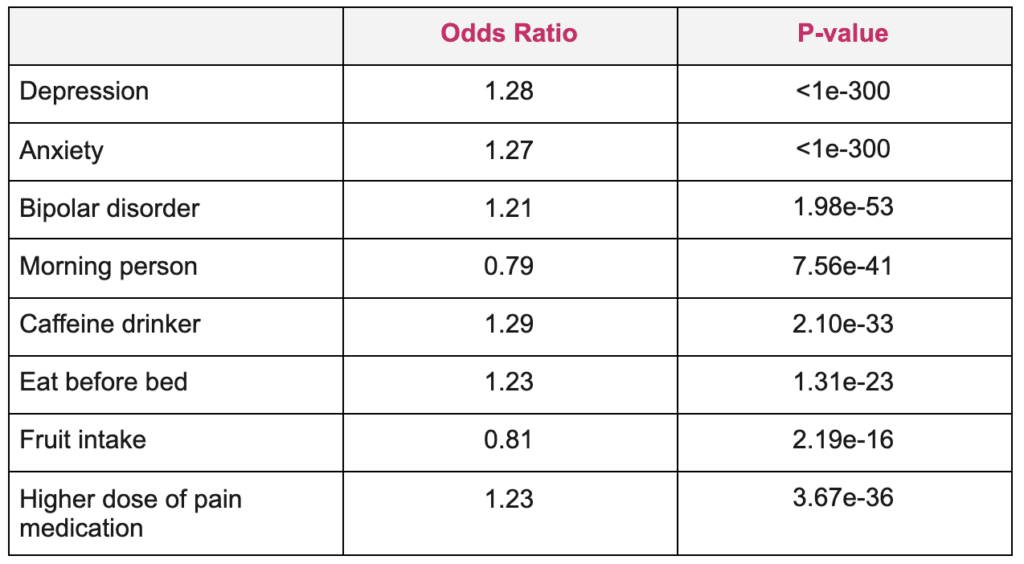By Alexa Reynoso, 23andMe Associate Scientist, Genetic Epidemiology
The use of electronic cigarettes, or vaping, is associated with several unhealthy behaviors and traits particularly among young people, according to new data from 23andMe.
But the data merely notes an association between vaping and those behaviors and traits, it’s not an indication of causation. Unlike the long-established research that links smoking to cancer, disability, and death, there remains a dearth of data on the health effects of vaping. Some recent studies have linked vaping to deleterious effects on the lungs. And last year a Stanford study found an association between risk for COVID-19 and vaping among young people.
Health Impacts
Scientists are still at the beginning of understanding the long-term health implications of e-cigarettes. At 23andMe we’ve only been collecting data on vaping for about a year. In the summer of 2020, our researchers added new questions to our smoking survey to account for vaping and e-cigarette use.
By looking at data we’ve gathered from the more than 76,000 customers who consented to participate in research and responded to our smoking survey, we were able to explore demographic and other characteristics of e-cigarette users. We were then able to compare people who vape to those who smoke just cigarettes, or who both smoke and vape (dual users), and those who don’t smoke or vape at all. (Note: This is not a representative sample of the entire 23andMe population, nor is it representative of national numbers. The CDC estimates that 4.5 percent of adults in the United States vape.¹ Among 23andMe research participants, only about .2 percent, or 19,000 individuals, reported being regular e-cigarette users. The sample for this research is composed only of respondents to our Smoking survey.)

What are E-Cigarettes?
Before we get into what the data showed, it’s worth understanding a bit more about how e-cigarettes work.
Introduced in 2004,² e-cigarettes were first touted as a less harmful way for smokers to kick their habit. Unlike with cigarettes, users of e-cigarettes are not inhaling smoke. They are inhaling a smoke-like aerosol, or vapor, produced when these devices heat a liquid that usually contains nicotine but also other potentially harmful substances.¹
While vaping may be helping some who are trying to kick their smoking habit, it may also be a gateway for others starting a nicotine addiction. This could be particularly relevant for young people. Juul Labs recently paid a $40 million settlement to the state of North Carolina for allegedly targeting youth in its marketing. According to a study on vaping trends published last year in the New England Journal of Medicine, it was noted that an increase in vaping among young people between 2018 and 2019 was “the largest of any substance tracked” in the last four decades.
23andMe’s Data on Vaping Among Young People
In looking at our data, 23andMe researchers found that those between the ages of 18-30 were more likely to vape.

Not only were young people more likely to vape, but these younger users of e-cigarettes were also more likely to use them at a higher frequency. Essentially, they take more “puffs” each day than older people in the study who vape. These findings are in accordance with those of the CDC.¹
Beyond being younger, individuals who are dual users — they smoke and vape — come from locations with a slightly lower median household income when compared to cigarette-only users, e-cigarette only users, and those that used none. Lastly, when comparing the four use groups in regards to years of education, research participants that do not smoke or vape tend to have obtained the highest amount of education.
Our researchers also stratified by sex and ethnicity but did not find strong differences as they did with age.
23andMe Insights
While we did not look specifically at health outcomes, we did look at various associations with unhealthy behavior and traits.
We found associations between vaping and such things as being more likely to be stressed, depressed, and anxious compared to those who do not vape. People who vape also were more likely to be diagnosed with bi-polar disorder. We saw associations between people who vape being more likely to report poor overall health, low life satisfaction as well as being less likely to exercise and eat right. People who vape in our data also were more likely to eat less fruit, drink more caffeine, need higher doses of pain medication, and are less likely to be a morning person. (More associations found with e-cigarette use within the 23andMe database are summarized in Figure 1. )


An environment-wide association study of cigarette smokers in our database was also conducted to determine if there are any fundamental differences between research participants that smoke e-cigarettes versus tobacco cigarettes.
Correlations
Our results indicated that the two groups are much more similar than they are different. Similar to the e-cigarette results, we saw that smokers were much more likely to experience depression and anxiety. Both cigarette and e-cigarette users also reported a lower general health score. Other interesting correlations (see Figure 2.) were that cigarette smokers tend to drink more alcohol and tend to be more hot-headed.


Although researchers uncovered correlations between smoking and certain demographic variables, it should be noted that correlation does not equal causation. Proving that certain behaviors or demographics cause another is quite difficult; meaning that we can’t say if someone isn’t a morning person they must be an e-cigarette user. In order to come to these conclusions, researchers must conduct years of extensive research consisting of numerous rigorous trials and studies.
That’s not to say what we uncovered so far is trivial, but rather we are on the right track. We are still just beginning to understand the long-term health implications of e-cigarettes. Over time, however, with the power of our large research cohort and scientific community, we could uncover more novel associations between e-cigarette use and long-term health effects.
23andMe customers who would like to contribute to our research efforts surrounding e-cigarette usage can take the survey here. Not yet a customer? Find out more here.
References
- “About Electronic Cigarettes (E-Cigarettes).” Centers for Disease Control and Prevention, Centers for Disease Control and Prevention, 28 Apr. 2021, www.cdc.gov/tobacco/basic_information/e-cigarettes/about-e-cigarettes.html.
- Cobb, Nathan K., et al. “Novel Nicotine Delivery Systems and Public Health: The Rise of the ‘E-Cigarette.’” American Journal of Public Health, vol. 100, no. 12, 2010, pp. 2340–2342., doi:10.2105/ajph.2010.199281.




